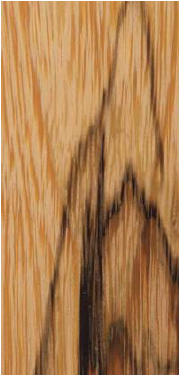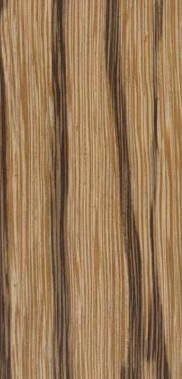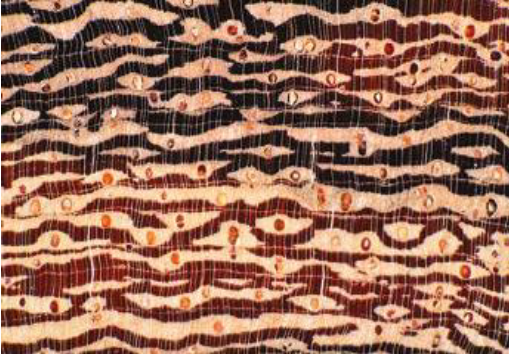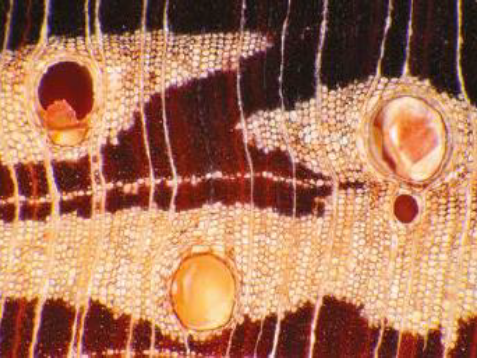Marblewood
| Family | Leguminosae ( Mimosaceae) |
| Botanical Names | Zygia racemosa |
| Continent | Latin America |
| CITES | (Washington convention of 2017)
No trade Restrictions |
| Diameter | 25 to 60 cm |
| Thickness of Sapwood | 2 – 3 cm |
| Buoyancy | Does not float |
| Log Conservation | Moderate (treatment recommended) |
Wood Description
| Reference colour | Sapwood | Texture | Grain | Interlocked grain | Notes |
|---|---|---|---|---|---|
| Orange Yellow | Not clearly demarcated | Medium | Straight or interlocked | Slight | Heartwood with irregular dark brown veins. These veins are not present in sapwood. Sometimes wavy grain |
Flat Sawn

Quarter Sawn

Physical and Mechanical properties
| Property | Mean Value |
|---|---|
| Density* | 1.03 |
| Monnin hardness* | 10.6 |
| Coefficient of volumetric shrinkage | 0.74 % per % |
| Total tangential shrinkage (Ts) | 10.5 % |
| Total Radial shrinkage (Rs) | 6.0 % |
| T/R anisotropy ratio | 1.8 |
| Fibre Saturation point | 28 % |
| Thermal conductivity | 0.33 W/(m.K.) |
| Lower heating value | _ |
| Crushing strength* | 83 MPa |
| Static bending strength* | 150 MPa |
| Longitudinal modulus elasticity* | 27,030 MPa |
Natural durability & Treatability
| Resistance to decay | Class 3 – moderately durable |
| Resistance to dry wood borers | Class S – suspectible (risk in all the wood) |
| Resistance to termites | Class D – durable |
| Treatability | Class 3 – poorly treatable |
| Use class covered by natural durability | Class 2 – inside or under cover (dampness possible) |
Preservation Treatment
| Against dry wood borer attacks. | This wood requires appropriate preservation treatment. |
| In case of temporary humidification | This wood requires appropriate preservation treatment. |
| In case of permanent humidification | Use of this wood is not recommended |
Sawing and Machining
| Blunting effect | Fairly high |
| Tooth for sawing | Stellite-tipped |
| Machining tools | Tungsten carbide |
| Suitability for peeling | Not recommended or without interest |
| Suitability for slicing | Good |
| Notes | Difficulties due to hardness and interlocked grain |
Drying
| Drying rate | Normal to slow |
| Risk of distortion | Slight risk |
| Risk of case hardening | No known specific risk |
| Risk of checking | High risk |
| Risk of collapse | No known specific risk |
| Suggested drying schedule | Schedule #7 |
Assembling
| Nailing/ Screwing | Good but pre – boring necessary. |
| Notes | Very high specific gravity: important that gluing be performed in compliance with the code of practice and instructions for the glue used. |
Cross sections of Buchenavia fanshawei


Commercial Grading
Sawn timber appearance grading
According to NHLA grading rules (2015) Possible grading: FAS, Select, Common 1, Common 2, Common 3 In Guyana , the local name of this species is Bois serpent. Grading is done according to local rules Bois guyanais classes (1990) Possible grading : Choice1, Choice 2, Choice 3, Choice 4.
Fire Safety
| Conventional French grading | Thickness > 14 mm: M3 (moderately inflammable)
Thickness < 14 mm: M4 (easily inflammable) |
| Euroclass grading | Default grading for solid wood that meets requirements of European standard NF EN 14081-1 (April 2016): structural graded timber in vertical uses and ceilings with minimal mean density of 0.35 and minimal thickness of 22 mm. |
Main End uses
- Turned goods
- Cabinetry (high-end furniture)
- Panelling
- Built- in furniture or mobile item
- Flooring
- Sliced veneer
- Marquetry
- Hydraulic works (seawater)